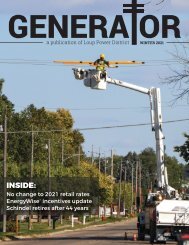Loup Generator — Winter 2022
Learn more about the invasive species in Nebraska and what you can do if you spot them. The 2022 list of financial incentives available to customers who make energy-efficient upgrades. Also in this issue, Mini-Splits 101: an introduction for homeowners.
Learn more about the invasive species in Nebraska and what you can do if you spot them. The 2022 list of financial incentives available to customers who make energy-efficient upgrades. Also in this issue, Mini-Splits 101: an introduction for homeowners.
You also want an ePaper? Increase the reach of your titles
YUMPU automatically turns print PDFs into web optimized ePapers that Google loves.
A new aquatic invasive <strong>—</strong> creeping water primrose (Ludwigia peploides) was<br />
found just off the <strong>Loup</strong> bypass reach in summer 2021. Photo by Michael Gutzmer.<br />
INVASIVE FLORA<br />
Nearly 400 species of non-native<br />
plants now grow in Nebraska. Most<br />
of these do not cause ecological or<br />
economic damage.<br />
Some species, however, are<br />
destructively invasive <strong>—</strong> infesting<br />
native prairies, woodlands, and<br />
wetlands; displacing native vegetation<br />
and degrading wildlife habitat; and<br />
harming cropland, yards, and gardens.<br />
<strong>Loup</strong> has numerous locations with<br />
aquatic species of plants that can be<br />
vulnerable to invasion from non-native<br />
species.<br />
New Century Environmental biologists<br />
have documented more than 200<br />
plant species on <strong>Loup</strong> lands since 2018.<br />
Invasive species in these areas include<br />
leafy spurge, Canada thistle, musk<br />
thistle, reed grass, common buckthorn,<br />
and purple loosestrife.<br />
The primary consequence of<br />
established invasive plants is that<br />
they displace native or more desirable<br />
plant communities. Invasive plants<br />
change the food web in an ecosystem<br />
by destroying or replacing native food<br />
sources. The invasive species may<br />
provide little to no food value for wildlife<br />
or livestock. Invasive species can<br />
also alter the abundance or diversity of<br />
species that are important habitat for<br />
native wildlife.<br />
“The grasslands of the Northern<br />
Great Plains are in the midst of extensive<br />
alteration and redistribution of<br />
important species,” Gutzmer said.<br />
“Invasive plants contribute to the<br />
degradation of these ecosystems and<br />
present monumental challenges for<br />
natural resource managers.”<br />
Widespread decreases in populations<br />
of grassland-dependent wildlife,<br />
particularly birds, have been documented,<br />
he said.<br />
Seth Gutzmer holds a silver carp found<br />
in a <strong>Loup</strong> River bypass backwater.<br />
Special thanks to New Century Environmental<br />
and Michael Gutzmer for information in this<br />
story. The company’s scientists and engineers<br />
assess and manage a variety of compliance<br />
and natural resources issues throughout the<br />
Great Plains.<br />
INVASIVE FAUNA<br />
Aquatic invasive species can cause<br />
lasting damage in water systems. Once<br />
established, these species may introduce<br />
disease, push out native species,<br />
drastically change food chains and<br />
physical characteristics, and damage<br />
equipment and water delivery systems.<br />
Silver carp, an invasive fish species,<br />
are found in the <strong>Loup</strong> canal, the <strong>Loup</strong><br />
River bypass, and the lower Platte River.<br />
Invasive species of concern in<br />
Nebraska include the zebra mussel,<br />
quagga mussels, New Zealand mud<br />
snail, Asian clam, and Chinese mystery<br />
snail. Active monitoring has become<br />
necessary in preventing the spread of<br />
these species and minimizing damage<br />
to our aquatic resources.<br />
Other invasive species of concern<br />
include Eurasian collared-dove, European<br />
starling, house sparrow, and rock<br />
dove. These species are well established<br />
in <strong>Loup</strong>’s service territory and controlling<br />
them would be very difficult. There<br />
is potential for various invasive insects<br />
and feral hogs to become a concern in<br />
the future as well.<br />
stop the spread<br />
Here are some tips to help stop the spread<br />
of invasive species. Keep these in mind<br />
anytime you visit any <strong>Loup</strong> park as well as<br />
state and national parks.<br />
Don’t let it loose! Do not release pets<br />
into the wild or dump aquariums or bait<br />
buckets into waterways. Unused bait<br />
should be discarded into trash cans.<br />
Clean, Drain, Dry. Thoroughly rinse your<br />
gear and pressure wash your boats, skis,<br />
and other recreation vehicles on site.<br />
Plants and aquatic organisms can get<br />
into any place water can get into. Use hot<br />
water if available.<br />
Don’t keep invasive species as pets<br />
and don’t choose invasive species for your<br />
landscaping.<br />
Wash your vehicle, especially if you<br />
have been driving on unpaved roads or off<br />
road. Plant materials can get stuck in your<br />
tires and undercarriage. This includes<br />
cars, bikes, and ATVs.<br />
Shake out your tent, camp chairs,<br />
sleeping bags, and other camp<br />
accessories before leaving the campsite<br />
to remove any plant or seed materials.<br />
Brush off or wash your pets.<br />
Sticky seeds can hitchhike on their fur.<br />
Clean your shoes or boots by knocking<br />
dirt and plant materials out of the treads.<br />
Consider carrying a boot brush in your car<br />
or pack. Rinse the soles if possible.<br />
Don’t move firewood. Use local<br />
firewood. Do not bring in firewood<br />
from outside the immediate area.<br />
<strong>—</strong> from the National Park Service<br />
have you spotted an invasive species?<br />
• Report your sighting at neinvasives.com<br />
• Report aquatic invasive species (AIS)<br />
to the Nebraska Game & Parks Commission<br />
at ngpc.AIS@Nebraska.gov or 402-471-7602<br />
WINTER <strong>2022</strong> | 7
















